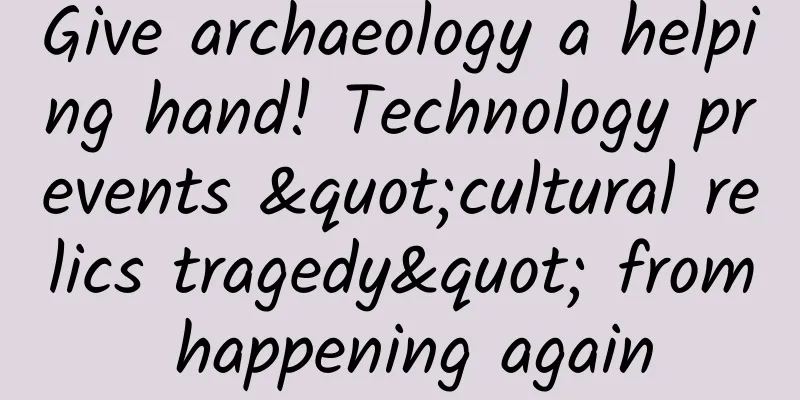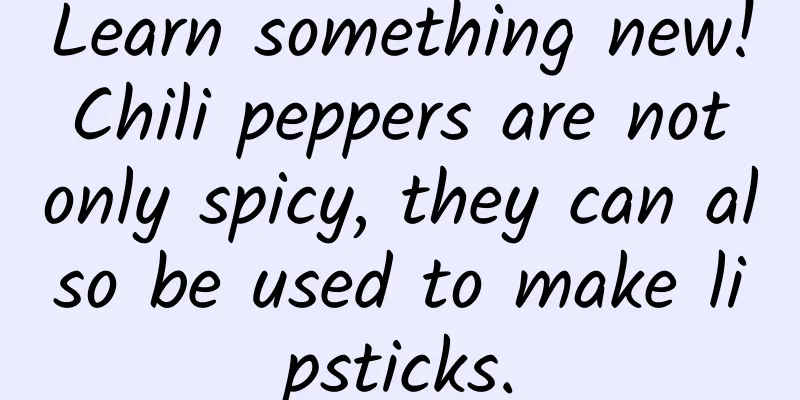Give archaeology a helping hand! Technology prevents "cultural relics tragedy" from happening again

|
In the long history of China over 5,000 years, there are countless underground tombs. After entering the 21st century, "national-level archaeological discoveries" have been on the hot search every now and then, such as the Liangzhu Culture Ancient City Site in Yuhang, Zhejiang in 2007, Cao Cao's Mausoleum in Xigaoxue, Anyang, Henan in 2009, the Tomb of Emperor Yang of Sui in Caozhuang, Yangzhou, Jiangsu in 2013, the Tomb of Liu He, Marquis of Haihun of the Western Han Dynasty in Nanchang, Jiangxi in 2015, and the Sanxingdui Ruins that shocked the world in 2021. This year, the Wuwangdun Tomb has become a hot topic that has attracted the attention of many archaeology enthusiasts. After four years of exploration and excavation, this large-scale, high-level tomb of the Chu State, which is the largest, highest-level and most complex in structure, began to extract cultural relics in March this year. A series of new archaeological discoveries have attracted much attention. Archaeological excavation site of Wuwangdun Tomb No. 1 Rescue excavation Wuwangdun Tomb is located in Xuwa Village, Sanhe Town, Huainan High-tech Zone, with Shungeng Mountain to the north and about 15 kilometers to the west of the Chu Shouchun City Ruins. It is a high-level large tomb of the Chu State in the late Warring States Period. In 2020, relevant archaeological work was officially launched and included in the key projects of the "Archaeology China" subject. In fact, the archaeological community does not take the initiative to excavate imperial tombs. Wuwangdun Tomb is one of the few large-scale tomb excavation projects approved by the State Administration of Cultural Heritage in recent years. This is because archaeological work is by no means as simple as "digging for treasure". The protection of unearthed cultural relics is not an easy task and faces many challenges, such as the sudden increase in oxygen content in the air, fluctuating temperature and humidity, changing light, and rapidly multiplying harmful organisms, which are all "natural enemies" of unearthed cultural relics. For cultural relics buried deep underground, once they "see the light of day", they will lose the environment they rely on for "survival" and will have strong inadaptability. If not handled properly, it is easy to corrode or even carbonize, causing irreversible damage. Therefore, when unearthing cultural relics, we should not only consider how to excavate, but also pay attention to how to protect them. In the history of Chinese archaeology, there have been more than one cases where unearthed cultural relics have been damaged due to improper protection. For example, the excavation of the Dingling Mausoleum of Emperor Wanli is considered a major tragedy in the history of archaeology. Although the staff took many protective measures, due to the limitations of the technical level and supporting archaeological equipment and facilities at the time, the calligraphy and paintings, books, silk fabrics and other cultural relics that had existed in the tomb for hundreds of years turned to ashes after coming into contact with the air. The excavation of the Terracotta Warriors, known as the "Eighth Wonder of the World", was also full of regrets. Most people have seen the gray-black Terracotta Warriors, but in fact the Terracotta Warriors were colorful. However, due to the influence of the technical level and equipment settings at the time, the painted patterns on the Terracotta Warriors were rapidly oxidized and corroded within just a few minutes after they were excavated, and became "gray and dirty" at a speed visible to the naked eye. The original intention of excavation was to discover cultural relics and study history, but the result was to destroy cultural relics, causing a lot of precious historical information to disappear completely, bringing immeasurable losses. This is why as early as 1987, the Wuwangdun Tomb was listed as a national key cultural relic protection site, but was not actively excavated and developed. However, this large-scale and complex ancient tomb also attracted the covetousness of a large number of tomb robbers, who regarded it as a "wealth code". The tomb robbers excavated the Wuwangdun Tomb three times. Because the holes they dug caused a lot of rainwater to enter the tomb chamber, the tomb chamber was in a mess, and the safety of the underground cultural relics was threatened. Archaeologists had to start rescue excavations. Experts said that the Wuwangdun Tomb provides systematic archaeological data for studying the high-level mausoleum system of the Chu State in the late Warring States Period, as well as the history and culture of the Chu State after its eastward migration. New archaeological discoveries are certainly exciting, but how to protect the integrity of the excavated cultural relics and prevent the recurrence of historical tragedies has always been a "Sword of Damocles" hanging over the heads of the staff. Archaeological staff extract fragile cultural relics on site Archaeological “Black Technology” Today is different from the past. After nearly 4 years of excavation, more than 1,000 days and nights, behind the hard work of archaeologists, we already have a lot of "black technology" to support archaeological excavation work, and an era of digital archaeology has arrived. Wuwangdun Tomb No. 1 is the main tomb of the cemetery. It is a vertical pit tomb in the shape of "甲" with a mound. It is about 16 meters above the ground and has a total area of about 12,000 square meters. There are 21 steps on the four walls that gradually retract inward. The outer coffin chamber is built with huge beams in the shape of "亚", with the coffin chamber in the center and a side chamber on each side. The entire outer coffin chamber is divided into nine chambers, which some people jokingly call "eight rooms and one hall". How to find the coffin chamber and clarify its layout in such a large area through the thick earth? The high-density resistivity measurement technology known as "geo-CT" plays a big role. Due to the different conductivity of underground media such as rocks and soil, archaeologists arranged dozens to hundreds of electrodes at a time, which is equivalent to invisible drilling. Each depth measurement point can be understood as a borehole, collecting the resistivity of different strata, so as to judge the situation under the soil and find out the layout of the coffin chamber. The archaeological team extracted a large number of cultural relics, including bronze ritual vessels, daily utensils, lacquered wooden objects, musical instruments, figurines, etc., among which the number and variety of lacquered wooden objects are unprecedented. Due to the large number and variety of cultural relics, manual statistics and archiving are time-consuming, labor-intensive and prone to errors. At the archaeological excavation site, every time a cultural relic is unearthed, the archaeologists will attach a label with a QR code to the outside of its cover after the corresponding protection treatment, and scan the code for entry. Using the digital platform, the archaeological site, time, location of the discovery of cultural relics, classification of cultural relics and other information can be recorded in detail, just like the delivery station distributes express, and the whereabouts of cultural relics can be tracked at any time. Unearthed cultural relics - wooden figurines The text has a special archaeological value. A large number of ink-written characters were found on the cover of the coffin chamber of Tomb No. 1, with more than 100 sentences and nearly a thousand words, indicating the position, order and function of each coffin chamber cover. This is of great significance for studying the construction process of Chu tombs, the official system, and the names of objects. However, due to thousands of years, most of the ink marks on the wood have long been unrecognizable to the naked eye. Infrared imaging technology has become the "perspective eye" of archaeological experts. They use the principle of infrared light penetration - wood and ink have different degrees of absorption of infrared light, and infrared light can keenly capture the blurred ink information on its surface. Use a special camera or scanner to record the image with enlarged color contrast, and you will get an infrared photo. More than 200 meters away from the archaeological excavation site, there is a 3,000-square-meter modern archaeological laboratory. The archaeological laboratory is equipped with low-temperature sterilization rooms, inorganic cultural relics protection rooms, analytical laboratories and other rooms. The multidisciplinary research team continues to conduct systematic analysis and research on the cultural relics and relics unearthed from Wuwangdun Tomb No. 1, and carries out reinforcement extraction and stability protection of various fragile cultural relics and complex accumulation relics. Researchers working in the protection room The laboratory can be seen as a "safe house" for unearthed cultural relics. It can precisely control the humidity and switch between normoxic and hypoxic modes to simulate the original burial environment of cultural relics, provide immediate protection for unearthed cultural relics, and meet the dehydration and shaping needs of wooden cultural relics such as saturated lacquered woodware and coffin chamber covers, so as to avoid damage to cultural relics due to sudden changes in the environment after unearthed. At the same time, the hypoxic archaeological laboratory can also realize emergency, rapid, and zero-chemical disinfection of unearthed cultural relics, and has insecticidal and mildew-proof functions. In addition to being a "safe house", the hypoxic archaeological laboratory is also a "rescue room". After completing the reinforcement and extraction of fragile cultural relics such as coffin covers, bamboo mats, and lacquered wooden objects, the archaeological team of Wuwangdun will carry out more refined rescue and protection of cultural relics in this "rescue room". This time, in the process of archaeological exploration, cultural relics extraction, on-site protection and other archaeological excavation work, multiple scientific and technological means were applied through multi-disciplinary and multi-platform collaboration. At present, the on-site excavation has entered the second stage of the coffin chamber excavation, that is, the excavation and cleaning of the coffin chamber. As the excavation continues to deepen, more scientific and technological means will play an important role in the archaeology, research, protection and utilization of Wuwangdun Tomb No. 1, making the archaeological value of Wuwangdun Tomb No. 1 more clear and comprehensive. Perhaps by then, more unsolved mysteries of this tomb will also be revealed to the world. |
<<: Don’t say “pink and tender”, it is the real version of “beautiful scenery in the desert”
Recommend
Taobao SEO: Comprehensive search keyword optimization skills
1. Normal word search In general, many of our way...
Cadillac Minister Feng Dan calls for anti-counterfeiting on Pinduoduo: refurbished cars, fakes
"Refurbished cars, fakes." Shanghai'...
Stay tuned! What should you do if you are assaulted or sexually harassed? You must know these things
Expert of this article: Zhu Guangsi, science writ...
New Studio "Wen Jun Screenwriting Master Class" enters the film industry from the creation
The screenwriter is the first person in the creat...
Inventory of essential tools for new media operations (dry goods collection)
We also need to arrange a good-looking layout How...
Product activity operation and promotion planning plan!
Activities are a very important way to quickly at...
Why is it not recommended to turn off the lights at night to play with mobile phones? It would be great if you knew these hazards earlier
Mobile phones are the most important electronic d...
Two English teachers want to rule the world? What will happen if Hammer "gets on board" with Alibaba?
"Two English teachers are going to rule the ...
How to improve the effective conversion rate when running advertisements?
In the process of search advertising , many corpo...
Haobo's supercar made for China won high praise from CCTV International
The 6th CIIE showcased over 400 new products, tec...
Can oxygen-enriched water replenish oxygen in the body? It is useless and unnecessary
The article is produced by "Science Refutes ...
When will the spring semester in Guangdong start in 2020? When will the spring semester in Guangdong start in 2020?
According to the current epidemic prevention and ...
Not too quiet: US requires electric cars to have sound
Recently, according to the automotive news websit...
On the winter solstice, people in the north eat dumplings and people in the south eat glutinous rice balls?
“If you don’t eat dumplings during the winter sol...
Camping is great, but safety is more important! Here are some tips for camping during the pandemic
Some netizens said: There is a tent set up on eve...









